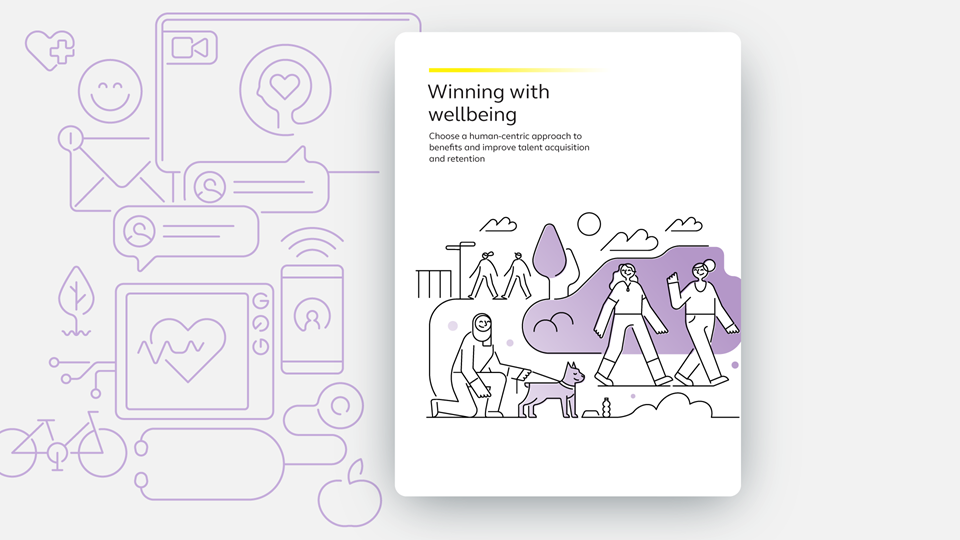Provide access to new benefits that are meaningful and valued by employees and their families

Wellbeing does not begin or end with a single benefit program. Similarly, there’s no one-size-fits-all solution to wellbeing in the workforce. As employers are increasingly challenged with how to meet the needs of their diverse workforce, benefits flexibility and choice are proving crucial to engagement, retention and new talent acquisition.
Recent data from Fringe, the leading lifestyle benefits platform behind the Alight Wellbeing Marketplace, and from Alight’s Winning with Wellbeing report suggests that lifestyle benefits can have maximum impact with modest investment and employers who tailor benefits around employees’ life stages, with support for a broader range of goals (i.e., not just retirement savings) would significantly improve acquisition and retention.
Below are some of the other key findings from Alight and Fringe’s research, as well as best practices for improving wellbeing with flexibility and choice.
Employers who carefully configure benefit packages to reach different employees based on life stages can be equally or more successful than those who offer more benefits. 1
It’s important to note that there’s a strong disconnect between what employees want and what employers think employees want. Appreciation can be more effective than rewards. In an environment where companies are increasingly tasked with doing more with less, their support of employees should be focused on getting people to use the benefits they have invested in as well as manage costs.
Lifestyle benefit stipends, for example, are the most popular and effective programs among employees. Unlike Rewards & Recognition (R&R) programs, they are not conditional. Lifestyle stipends reflect appreciation —they say, “you matter to this organisation no matter what,” which is proven to be more powerful than recognition that says, “you matter to this organisation if you do these things.”
of employees say lifestyle benefits signal company culture 2
Benefits reflect a company’s values and principles. People want to work for companies that take employee needs seriously and treat workers as individuals.
Employees want benefits that go beyond basic protections and show that employers acknowledge them as individuals with unique personal needs, commitments and objectives. Further, they want their employers to appreciate their contributions to the business.1 To meet these needs and improve or rebuild employee trust, companies must provide access to a broad range of wellbeing services and life-stage benefits that are most meaningful to employees.
In considering their job satisfaction, employees take into account more than just pay, health insurance and retirement savings. Many employees view a supportive organisational culture as a benefit in itself.1
Alight reinforces our Being Benefits (see me, know me, support me, protect me, value me) framework aligned to Maslow’s Hierarchy of Needs within the Alight Worklife® platform to help ensure all users feel seen, heard and considered regardless of background and/or culture. For example, employers will find an array of non-traditional benefits, such as food delivery service, in the Alight Wellbeing Marketplace to engage people who express the need for support in certain areas of their lives that are not supported by traditional benefits. This expanded choice also supports employees’ personal health, as well as religious or spiritual beliefs that may influence their dietary needs and choices.
By optimising both the benefits they offer and how they are presented to employees, employers can improve their talent acquisition and retention outcomes and restore employee trust.1
To maximise their investment in people, employers must assess their workforce and consider flexible ways to meet employee needs by providing benefits that are personal, meaningful and valued. A fully customisable benefits package for each employee may seem like the right approach. But that is not what employees want.
Our research shows that a strong core of benefits and a customised benefits experience will better meet employee needs, including increased flexibility. Such an approach would feature intuitive interfaces, transparent information and targeted messaging for individuals.
Once you’ve determined the top needs of your workforce, you can begin to implement benefits technology that creates a stronger, healthier employee experience by meeting people in their moments that matter. Once implemented, you’ll see better outcomes for employees, improved cost efficiencies and a stronger bottom line.
of employees say flexibility is important in wellbeing benefits 2
Wellbeing means different things to different people. For some, it’s a trip to the gym or a massage. For others, it’s pet-sitting or a family dinner. The key to an effective wellbeing program, however, is flexibility; employees need to be empowered to satisfy their needs as they see fit.
Alight recommends curating the wellbeing experience with services and experiences aligned to the unique requirements of different life stages to provide employees with access to the flexible support they’re looking for. Flexible benefit plans aligned with life-stage needs yield significant value for both employees and employers, including financial gains and improvements in talent management outcomes.1
Companies that offer flexible benefits have 84% higher employee loyalty than their competitors. 2
Two in three employees report greater happiness as a result of lifestyle benefits in the workplace. Duly noted, happiness is a critical metric in assessing employee engagement, and increased employee engagement has long been a cornerstone of any successful benefits strategy.
To offer the flexible benefits that employees desire, companies must evolve their benefits ecosystem and take a holistic approach to wellbeing by providing access to a wide range of services and experiences that are most meaningful to employees.


